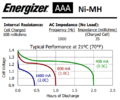abdulbadii
Member
What is it all about on NiCd recharge battery internal resistance (BIR), as its knowledge on
https://www.quora.com/How-do-you-test-AAA-batteries-with-a-multimeter/answer/Almaghfuur-Lahu
roughly tell this mind-confusing one which has bad BIR at least 7.7 ohm due to MM tested it 1.53 V 0.17 A
how to reduce or "dissolve" this BIR
https://www.quora.com/How-do-you-test-AAA-batteries-with-a-multimeter/answer/Almaghfuur-Lahu
roughly tell this mind-confusing one which has bad BIR at least 7.7 ohm due to MM tested it 1.53 V 0.17 A
how to reduce or "dissolve" this BIR


